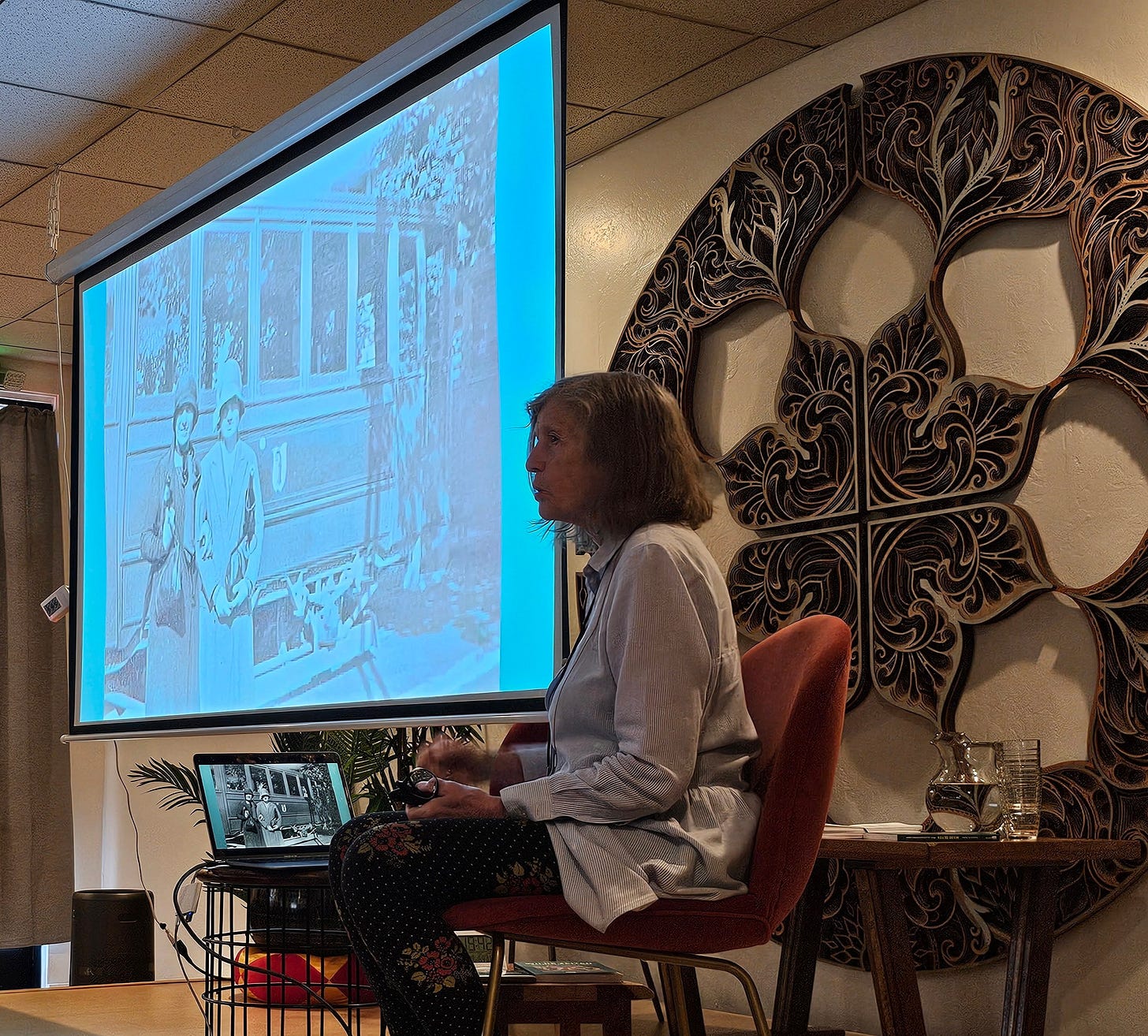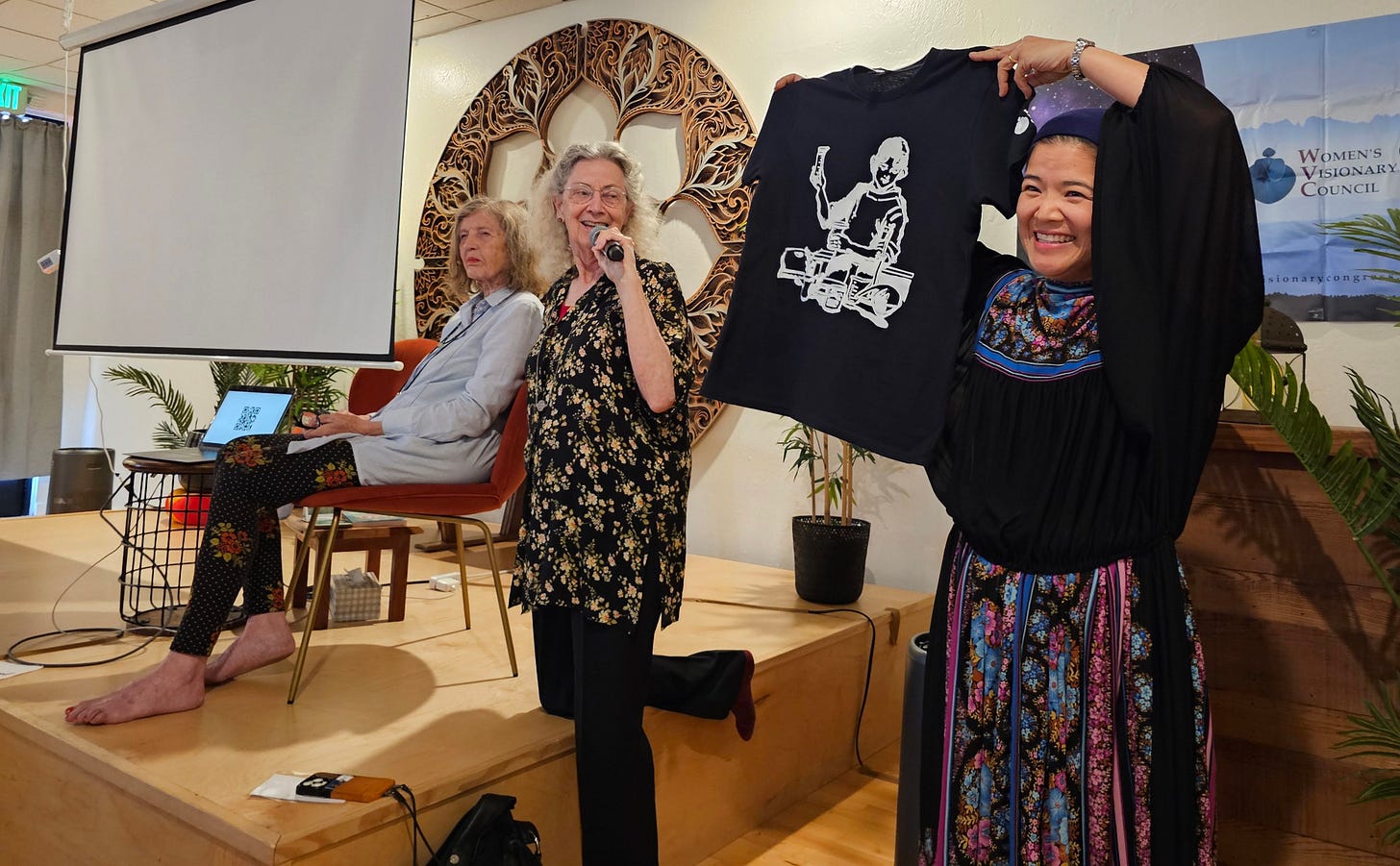Tram Day: on Psychedelic Women and Poisoned Bread
Celebrating Susi Ramstein, the first LSD trip sitter
As most folks know, LSD-25 was first synthesized at Sandoz Laboratories in Basel, Switzerland by Dr. Albert Hofmann in 1938. A few years later, on April 19th, 1943, Dr. Hofmann became the first person to ingest LSD on purpose. That event has since been popularized as "Bicycle Day," which commemorates the ride he took home from his lab that afternoon. What most folks don’t know is that right next to Hofmann, on a bicycle of her own, rode a woman named Susi Ramstein. Susi was Hofmann's laboratory assistant and, on that day, became the world's first LSD guide.
On June 12th of that same year, 22-year-old Susi ingested 100 micrograms of LSD-25 at Sandoz — becoming not only the first woman to take acid but also the first woman to take acid at work. After the peak of the trip, but still very much in the embrace of the drug, she rode the tram home.
Cloches, corsets, and the tram: Susi’s setting. For some reason, tripping Susi found the appearance of her fellow passengers comical.
On June 12th of this year, as part of the monthly Chalice psychedelic salon, the Alembic and the Women's Visionary Council were joined by Susanne Seiler, the world's preeminent scholar on Susi Ramstein. All together, we inaugurated Tram Day, a new holiday that commemorates Susi and celebrates psychedelic women everywhere.
Kristina Soriano from the Women’s Visionary Council displays a t-shirt depicting Susi Ramstein while WVC co-founder Maria Mangini and Suanne Seiler look on
As one of those psychedelic women, this holiday is personally very meaningful to me. The peak of my psychonaut days coincided with the beginning of my study of neuroscience, and during those years, I often was the only woman in the room. I found myself frequently deferring, in a way I'm sure many of us are all too familiar with, to the opinions and interests of the men around me. The psychedelic, scientific, and dharmic authors I was reading at the time were also nearly all male, and I found myself, in all sorts of unconscious ways, compromising my experience, fitting it into a male lens, and orienting towards my womanhood as an unfortunate limit to be denied and overcome.
On Bicycle Day during my sophomore year in college, I was hiking with my usual companions - two male psychonaut buddies - in the mossy woods behind an ashram in Western Massachusetts. That day, for the first time, I clearly saw all of the ways that I had been deferring to both of them. I saw and felt our shared personal pasts, all of the times that two of us had been moved simultaneously by an impulse to speak and how in all — all — of those moments I had silenced myself: “no, you go.” I saw each of those little things that were not little things, each tiny momentary deferral a pointillist dot in a much larger, until-then-invisible painting. I saw and re-experienced several of the insights that my two friends had uncovered in my presence, during those times of my silence. On that Bicycle Day, in those woods, I said out loud to them: “I’m doing this for the women.” It felt incredibly important to say that out loud, and completely unimportant to clarify what “this” was. This particular hike? This particular incarnation? Something in between? It didn’t matter. What did matter was that, in that moment, the feminine was elevated and began to take its place alongside and complementing the masculine, in the world of things.
The resonance between that distant Bicycle Day and this recent instantiation of Tram Day feels at once like a completion and a new turning. But most of all, it feels like one of those familiar sacred coincidences that pepper psychedelic experience, a synchronistic wink, nod, and grin. (Another wink is the fact that June 12th is also the day, in 1970, that Dock Ellis pitched his legendary no-hitter on LSD.)
In addition to the variety of gender expression out in the world, every one of us contains feminine and masculine poles within ourselves. Privileging one side of that spectrum while suppressing the other denies us the beauty and complexity of our fullest expression. I hope that Tram Day emphasizes, illuminates, and celebrates the feminine side of consciousness, as well as honoring all those women — forgotten, acknowledged, and newly remembered — without whom psychedelic culture as it is would be unimaginable.
Susanne is one of those women as well. Over the course of the evening, she shared with us her adventures: the hunt through the archives for Susi’s story, an escapade to explore Albert’s former home (“We brought Swiss TV, so they let us in”), and her own experience founding The Gaia Media Foundation and the Psychedelic Salon at the Cabaret Voltaire. She told us about Sandoz’s history of research into ergot derivatives (of which LSD-25 was, well, the 25th) and all about how the ergot was cultivated prior to the development of synthetic versions.
Susi & Susanne
Per usual Chalice convention, the first half of the evening was live-streamed and the second half was an unrecorded question and answer session. You can find the video of the lecture here, and selected excerpts of the unrecorded Q & A are provided below.
There are many, many threads to unravel in this discussion, and I encourage you to pay special attention to new ideas, phrases, people, and concepts, but also to dive in where your delight and intuition guides you.
Enjoy.
Kali Barbie made an appearance.
Q: When the Sandoz scientists discovered LSD and began exploring it, did they have any context to understand what they were experiencing? Did they know about other hallucinogenic compounds? Natural ones?
SS: Well they knew that it all came from ergot, which is a natural fungus that was studied at the very outset of pharmacology. The first written records of ergot poisoning come from the Middle Ages, when bread would sometimes get contaminated. It was also used as a medicine in childbirth, already in the Middle Ages. When you give birth, people think that the dangerous moment is when the child comes out. No, the dangerous moment is when the placenta comes out. Ergot helps support the process of contraction, and helps reduce bleeding afterwards. They use it to this day. Its original brand name was Methergine, which was the product that Albert Hofmann first developed. It was the most used medicine in childbirth for a long time.
Q: But did it make people hallucinate?
SS: No, not at all.
Q: So when Sandoz scientists were having these experiences on LSD, what did they think was happening?
SS: They thought they were poisoned. The infected bread in the Middle Ages had pure ergot on it. It was not a derivative, like Methergine, which they made sure wasn't poisonous before they fed it to people. The scientists didn't know that LSD-25 was going to be this extraordinary visionary substance. But they soon found out, because they had to test everything themselves.
Maria Mangini: When you describe the experience that Susi Ramstein participated in, it sounds as if Hofmann was at first quite frightened by what was happening. He really thought he had done something dreadful to himself, because it was such a strange experience.
SS: Yes, yes — at first, he was really frightened. A neighbor woman brought him some milk, and he thought that she looked like a witch. He was really not having such a good time. After the doctor came and found nothing wrong with him, other than dilated pupils, then he calmed down. And then also, I think maybe he was past the peak of it, and he started to enjoy himself.
MM: As Susanne learned when she interviewed Susi Ramstein, Susi was the one who summoned the doctor. If I understood correctly, the family doctor wasn't available. So then she summoned another doctor to come and give him an actual diagnosis.
I'm thinking about all these interventions, not only accompanying Hofmann home on the bicycle trip, but then getting the neighbor to bring the milk and calling first one doctor and then getting another doctor. These really help identify what Susi Ramstein was doing. I don't really like the term “psychedelic guide” because I don't know that any guiding is really needed. I would think of it as ground control, like the facilitator role that we now make so much of. Susi really was the first person to participate in this way, at least where LSD was concerned.
SS: She was the first trip sitter essentially.
Question: You were talking about ergot, the fungus that Sandoz used to derive lysergic acid. You talked about the people that actually planted the fields and harvested the ergot. You said some of them were women who came from reformatories.
Susanne Seiler: Yes, they were “fallen women,” as they called them in those days. These were women who had children out of wedlock, or who for some reason or another had a bad reputation. They stuck them in these places, and they also made them work. Sandoz paid them a little bit better than what they would normally get, but they also exposed them to great health hazards. To be fair, I don’t think they knew how bad it was going to be in the beginning, but they did find out soon enough that it was not so good.
Q: When the scientists were self experimenting, how much documentation did they create? Did they write trip reports and other things of that kind? And where is that documentation now?
SS: It’s both with Sandoz in the archives, and at the University of Bern, as part of Albert Hofmann's personal archive. I've looked at it. They’re just notes — “and then so and so took it and then so so did…” It's pretty dry, but it's there. They didn't write much about their experiences. Hofmann was the one who was most eloquent about what he experienced.
MM: Susanne, could you say something about how it has been for you to get access to that archive material?
SS: Well, at the University of Bern, it's not so difficult, but still, I have to fill out a form, I have to tell them what the purpose was, why I wanted to see this material. But then they were very, very nice about it. When I go to a place like that, I always take a little present. So I brought the man some of the dried fruit that I made myself. And he was very pleased. And so I'm always welcome there!
The other half was going to Novartis and that's much more difficult, much, much more difficult, because they're a pharmaceutical company, their reputation for them is what counts. Like all these big corporations. They do good in the medicines that they produce. But they also are pretty ruthless in getting what they want. Novartis especially has been attacked a lot. So they're very wary about anybody they let in the door. And you have to convince them somehow. It took me the longest time to even just get a contact, and then to talk to the archivist. Now we're very friendly with each other. But after two years of trying, I still haven't gotten the material I want. But I think I'll go again, and I'll try some more. You know, until I get what I want.









I'd love to know more specifics about the intersection between gendered consciousness and psychedelic experience.